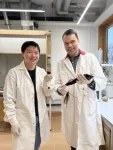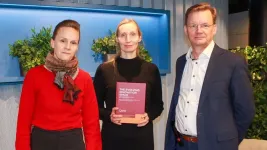(Press-News.org) Do you see the glass as half empty or half full? If you rewind to the start of the COVID-19 pandemic, chances are you experienced some level of pessimism. And who could blame you? With social isolation, health concerns and economic uncertainty, fear and anxiety became a daily reality for many.
A team of researchers from Syracuse University and Michigan State University recently explored the personal characteristics that help people handle prolonged stressors, such as the pandemic. Led by Jeewon Oh, assistant professor of psychology in Syracuse University’s College of Arts and Sciences, the group delved into optimism and pessimism and how those mindsets influence well-being.
The group utilized data from the Health and Retirement Study, a large-scale panel study that gathers a nationally representative sample of Americans aged 50 and older (Sonnega et al., 2014). In 2016, participants responded to questions assessing their levels of optimism, such as “In uncertain times, I usually expect the best,” and pessimism, such as “I hardly ever expect things to go my way.” During the COVID-19 pandemic (between March and May 2020), respondents answered questions on health-related behaviors that either increased or reduced the risk of COVID transmission, including masking frequency, travel habits and the likelihood of staying home.
The team used this data to explore how people’s mindsets affected their psychological and physical well-being during challenging times. Among their findings, they found that greater optimism promotes resilience and well-being when faced with stressors like the pandemic, while lower pessimism is linked to safer health behaviors. Their findings appeared in the Journal of Research in Personality.
In the following Q&A, Professor Jeewon Oh shares some key insights from their research.
What was the motivation for this study?
Jeewon Oh (JO): The pandemic introduced many changes, and we wanted to know more about personality traits that can help people cope with enduring and uncontrollable stressors like the pandemic. We examined optimism, because it motivates action. Since optimists view stressful situations positively, they are more likely to directly address the issue or try to adapt when things are uncontrollable.
What were the benefits for those who were more optimistic? How did optimism/pessimism correlate with well-being during the pandemic?
(JO): Both optimism and pessimism had independent associations with psychological well-being. So, people who are more optimistic and less pessimistic worried less, were less stressed and lonely and were more resilient. This was partly because these people engaged in more physical activity and perceived more social support and less strain from their relationships.
Interestingly, when it came to COVID/health-relevant behaviors, pessimism played a significant role, but optimism didn’t. In other words, individuals with a less pessimistic mindset (but not a more optimistic mindset), who have weaker negative expectations tended to engage in less risky behaviors, such as traveling, and more activities at home ranging from watching TV and gardening to meditating.
How does optimism or pessimism influence the way people approach challenges and setbacks?
(JO): In general, regular optimism/pessimism isn't about thinking they wouldn't get sick, or they will be more likely to get sick (compared to others), but about knowing the reality and still thinking that things will eventually work out. This positive mindset helps people to problem-solve and cope. Afterall, if you think things would never work out, why would you even try?
Is there a way to boost one’s optimism during times when they may be more anxious, like during the pandemic?
(JO): It can be easier to think about doing what optimists do rather than trying to think differently (or change your optimism). So, people with lower pessimism mentioned changing their behaviors to adapt to the situation, meeting with people on Zoom more frequently and exercising at home (vs. going to the gym and meeting up with people in person). It was these changes in behaviors like exercising more that partly helped people's well-being.
What does this study reveal about health and psychological well-being in the post-pandemic world? What factors can we consider for maintaining and improving mental health?
(JO): There has been evidence before the pandemic that optimistic people fare well in many situations. Even though more research is needed to understand why, our study found that optimists fared better even during new difficulties. Therefore, developing optimism and learning how to flexibly cope can help maintain and improve mental health in diverse situations.
END
Optimism can encourage healthy habits
2025-02-21
ELSE PRESS RELEASES FROM THIS DATE:
Precision therapy with microbubbles
2025-02-21
The targeted treatment of brain diseases such as Alzheimer’s, Parkinson’s or brain tumours is challenging because the brain is a particularly sensitive organ that is well protected. That’s why researchers are working on ways of delivering drugs to the brain precisely, via the bloodstream. The aim is to overcome the blood-brain barrier which normally only allows certain nutrients and oxygen to pass through.
Microbubbles that react to ultrasound are a particularly promising method for this sort of ...
LLM-based web application scanner recognizes tasks and workflows
2025-02-21
A new automated web application scanner autonomously understands and executes tasks and workflows on web applications. The tool named YuraScanner harnesses the world knowledge stored in Large Language Models (LLMs) to navigate through web applications in the same way a human user would. It is capable of working through tasks in a coherent fashion, performing the correct sequence of steps as required by, for example, an online shop. YuraScanner was tested against 20 web applications, unearthing 12 zero-day cross-site scripting (XSS) vulnerabilities. The technique behind YuraScanner as well as the tool itself have been developed by researchers ...
Pattern of compounds in blood may indicate severity of gestational hypertension and preeclampsia
2025-02-21
Preeclampsia, a complication of pregnancy characterized by high blood pressure and high levels of protein in the urine (proteinuria), indicating damage to the kidneys or other organ damage, is the main cause of maternal-fetal death in Brazil and the runner-up worldwide. In a Brazilian study published in the journal PLOS ONE, the pattern of substances present in patient blood samples varied according to the severity of the preeclampsia concerned.
The findings from the study, which was supported by FAPESP, ...
How does innovation policy respond to the challenges of a changing world?
2025-02-21
Researchers from the University of Vaasa, Finland, and Kent Business School, UK, have gathered insights on innovation policy, its current status and future perspectives in their new book “The Evolving Innovation Space”. The book offers research-based insights on how innovation can best be used to drive economic change and to find solutions to global problems.
– In a changing world, where geopolitical tensions are rising and artificial intelligence is gaining ground, innovation policy must also be reconsidered from new perspectives, says Helka Kalliomäki, one of the editors.
With digital ...
What happens when a diet targets ultra-processed foods?
2025-02-21
Most dietary programs are designed to help people achieve weight loss or adhere to U.S. nutrition guidelines, which currently make no mention of ultra-processed foods (UPFs). UPFs – like chips or candy – are the mass-produced, packaged products that contain little or no naturally occurring foods. Eating UPFs is strongly associated with increased risk of diseases and early death.
Because almost no existing programs focus specifically on reducing UPF intake, researchers from Drexel University’s College of Arts and Sciences designed an intervention that included a variety of tactics to target the uniquely problematic ...
University of Vaasa, Finland, conducts research on utilizing buildings as energy sources
2025-02-21
The University of Vaasa has received funding from Business Finland for the FlexiPower research and development project, which focuses on developing and commercializing the "Building as a Battery" (BaaB) solution. The project aims to find solutions that utilize existing building infrastructure as flexible energy sources.
The goal of the FlexiPower project is to develop and commercialize a solution that enables the dynamic response of building heating and cooling systems to the needs of the power system. This innovation offers a cost-effective and scalable solution for balancing the power grid without significant initial ...
Stealth virus: Zika virus builds tunnels to covertly infect cells of the placenta
2025-02-21
Infection with Zika virus in pregnancy can lead to neurological disorders, fetal abnormalities and fetal death. Until now, how the virus manages to cross the placenta, which nurtures the developing fetus and forms a strong barrier against microbes and chemicals that could harm the fetus, has not been clear. Researchers at Baylor College of Medicine with collaborators at Pennsylvania State University report in Nature Communications a strategy Zika virus uses to covertly spread in placental cells, raising little alarm in the immune system.
“The Zika virus, which is transmitted by mosquitoes, triggered an epidemic in the Americas that began in 2015 and ...
The rising tide of sand mining: a growing threat to marine life
2025-02-21
In the delicate balancing act between human development and protecting the fragile natural world, sand is weighing down the scales on the human side.
A group of international scientists in this week’s journal One Earth are calling for balancing those scales to better identify the significant damage sand extraction across the world heaps upon marine biodiversity. The first step: acknowledging sand and gravel (discussed as sand in this publication) – the world’s most extracted solid materials by mass – are a threat hiding in plain sight.
“Sand is a critical resource that shapes the built and ...
Contemporary patterns of end-of-life care among Medicare beneficiaries with advanced cancer
2025-02-21
About The Study: This study found persistent patterns of potentially aggressive care, but low uptake of supportive care, among Medicare decedents with advanced cancer. A multifaceted approach targeting patient-, physician-, and system-level factors associated with potentially aggressive care is imperative for improving quality of care at the end of life.
Corresponding Author: To contact the corresponding author, Youngmin Kwon, PhD, email youngmin.kwon@vumc.org.
To access the embargoed study: Visit our For The Media website at this link https://media.jamanetwork.com/
(doi:10.1001/jamahealthforum.2024.5436)
Editor’s Note: Please see the article ...
Digital screen time and nearsightedness
2025-02-21
About The Study: In this systematic review and dose-response meta-analysis, a daily 1-hour increment in digital screen time was associated with 21% higher odds of myopia (nearsightedness) and the dose-response pattern exhibited a sigmoidal shape, indicating a potential safety threshold of less than 1 hour per day of exposure, with an increase in odds up to 4 hours. These findings can offer guidance to clinicians and researchers regarding myopia risk.
Corresponding Author: To contact the corresponding author, Young Kook Kim, PhD, email md092@naver.com.
To access the embargoed study: Visit our For The Media website at this link https://media.jamanetwork.com/
(doi:10.1001/jamanetworkopen.2024.60026)
Editor’s ...





